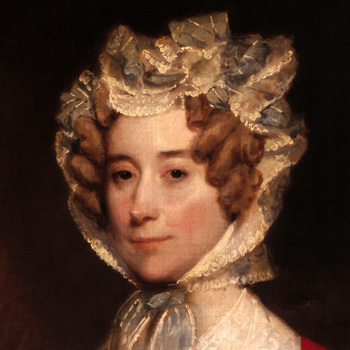Louisa Catherine Adams
Even in her role as the White House hostess, Louisa Adams felt a large degree of isolation. By following Elizabeth Monroe's custom of declining to return calls, she had less contact with other political spouses than she had when her husband held any other public positions. She organized regular dinners for thirty or more guests, but often absented herself from attending. Certainly her greatest event as hostess was in August of 1824 when she entertained the visiting Marquis de Lafayette, who was then completing a grand public tour of the United States. He and his large entourage stayed in the mansion requiring the presidential family to give up their private bedrooms and room together. Nor was the White House domestic staff large enough to serve the great Franco-American hero and Louisa Adams was required to hire extra servants.
She did break some traditions, encouraging dancing at her son's wedding and participating herself. At receptions, instead of standing apart from her guests with the Cabinet wives, she mingled. Uniquely, she was also one of only two known First Ladies, the other being Abigail Fillmore, who enjoyed providing musical entertainment for guests at the conclusion of formal dinners. An accomplished harpist, she was even painted with her prized instrument.
Few presidential relationships deteriorated as much as did that of John Quincy and Louisa Adams during their White House tenure. Adams consistently refused or ignored his wife's opinions or input even on matters involving their mutual personal well-being. It was not Louisa Adams' ideal of a "helpmate," which is what she had expected her role to be as First Lady. The couple spent many of their summers apart, with the First Lady away from her husband in Quincy, Massachusetts, in mid-Atlantic and New England spas, beaches and rivers where she indulged herself in rowing, swimming and fishing with other women friends. She also began reading the letters of her mother-in-law Abigail Adams and believed they should be published as an inspiration to all American women. The concept of "women's rights" and equality became a passion of her's and even a newspaper story of an Irish servant girl who committed suicide after being seduced by her master caused her great anguish.
For herself, she began writing more poetry and a series of bitter, sardonic plays, often skewering her husband. In one, "The Metropolitan Kaleidoscope" she writes sadly of the repressed spirit and intelligence of a character she named "Lady Sharpley" who was clearly herself. It is not known to what extent she encouraged the enactment of her plays. She also found refuge from political life by raising her own silkworms and harvesting her own silk, which she used in her personal sewing.
